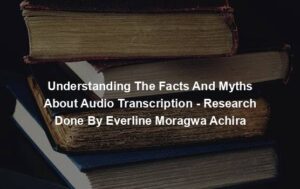Dubbing In Film, Video Games And Music.mp3 transcript powered by Sonix—easily convert your audio to text with Sonix.
Dubbing In Film, Video Games And Music.mp3 was automatically transcribed by Sonix with the latest audio-to-text algorithms. This transcript may contain errors. Sonix is the best audio automated transcription service in 2020. Our automated transcription algorithms works with many of the popular audio file formats.
The dubbing King Software presents. Dubbing in film, video games and music. A comprehensive guide. A brief synopsis on dubbing. When was the last time you had a long conversation with someone about dubbing? I'm talking about real dubbing, the process of providing films, video games or other types of media with audio that's different than the original language. Dubbing is a post-production process where the original language of recording is swapped with audio in a different language and is then mixed with the audio of the media to make it sound as natural as possible. It gets more complicated than that. But in a nutshell, that's what dubbing is. Though not very common for Americans to hear in films dubbed content is common in many other countries. For example, the majority of the world did not experience Avengers End game this past spring in English. Through the magic of dubbed content, allow non English speakers to get the full experience or a Singlish speakers. However, dubbing is still occasionally seen dark. Arguably, Netflix's hottest show at the moment was originally recorded in German. Though there are some English subtitles for those who wish to experience the original performance, which we also cover later on. The majority of people watch this show is adopt film, even though it might seem rare. A huge portion of Americans who watch the show experienced it with English dubbing, dubbing versus subtitles versus voiceovers.
What's the difference? This is where it can get a little confusing. If you're reading this and aren't super sure what the differences, we get it. On the surface, it can almost sound like voiceovers and dubbing are just different words for the same thing. They aren't. And it helps to understand the differences. The best way we can communicate the differences that dubbing is much more immersive than a voiceover. A voiceover generally tends to be narrative by nature. It does not capture the original tones of the actors and also does not sync up with the movements and mouths of the original characters. A voiceover communicates the message, but usually not the emotion. Dubbing, however, replaces the original audio as accurately as possible in order to create an immersive experience. This process is sometimes also called language replacement for movies, video games and TV shows. This can be the best option for creating natural sounding content if available. But then again, not every pro can give you natural so chose wisely. Subtitling versus dubbing. Although there is certainly some confusion between voiceovers and dubbing, subtitling couldn't be more different. Subtitling is the process of translating the audio into the target language and then having that translated text appear as subtitles on the bottom of the screen. If you are a true movie purist and you're watching a movie in another language, you will likely opt to watch the subtitled version rather than the dubbed version.
And we don't blame you. There's something that simply doesn't add up when lips and audio don't seem to match, subtitles allow the viewer to understand the foreign language while at the same time preserving the original vocal intonations and performances of the actual actors rather than some voice actors recorded in a studio. Whereas dubbing changes, the original audio and voice subtitling simply allows for the understanding, the message without compromising the original audio. That's not to say that dubbing doesn't come in handy, though. If the dubbing voice sectors are talented, it is often much easier to watch a movie or play a video game without having to read each and every subtitle. But this can be tricky to get dobbing in different media dubbing shows up all the time in our video games, movies and music, sometimes more often than you'd expect. Here it is. When you quickly realize there are more uses for dubbing than you may think at first. Especially in our globalized world. People want organic. They want naturale. They want a message to be effectively and seamlessly sent across the globe. This means that subtitling is good, voiceovers are better, but dubbing is the cream of the crop. Dubbing in films and movies. When we think of dubbed movies, the first thing that usually comes to mind is the idea of language replacement.
However, in film language, things can get a bit more specific. The term dubbing actually refers to the process in which filmmakers and editors take additional audio recordings and then mix them in to the original soundtrack to create the final polished soundtrack that you hear in the movie. A bit different, but overall the same intention dubbing in music. Just like with films, dubbing means something different altogether in the whimsical terminology of music, in music. This processes when you transfer or duplicate a song, the song in question can be transferred to a different media, more the same one. But the point is that the song is Copy Dover dubbing in video games, though dubbing in music and films takes on a very different meaning than it does normally. Video games break the mold in video games. It works pretty similarly, as we've explained above. You replace part of the original language with voice actors in a new language doc. There is a lot of discussion over whether subtitling or dubbing, also known as the Subs vs. Stubbs debate, is the best choice for video games. And you can find raging fan bases that will back up whichever position how dubbing works. Before we get into technicalities, it's critical to know that there are a few different methods that are used to dub content, ranging from looping to ADR to voiceovers.
It can get confusing pretty quickly. Fortunately, we are here to help you understand the different techniques used for all kinds of dubbed media and what they aim to do. What are the different kinds of dubbing? Five Relief's. Once all these steps are completed, you'll be ready to release your dubbed project. Congratulations. The release can have its own technicalities and implementations, but this will differ from project to project and medium to medium. And your done. Which should I choose from? Subtitling to dubbing Hédi arty lecturing and video games to films. It can all be overwhelming at first. We know. That said, it's worth taking the time to decide what will be the best fit for your project. A large part of deciding which route to take will depend on your budget and time constraints. It's great to get these defined before you start exploring your potential options recommendations. If you are interested in emotion and have a low budget subtitling, maybe the way to go. On the flip side, projects with more of a focus on ease of understanding and fluid use could be better suited for proper dubbing. Whichever route you choose, you can never go wrong with transforming your content to different languages or styles depending on your market and their needs. You'll expand your audience and get your content out to entirely different groups of people.
Remember, communication is in the middle of it all. And your ultimate goal is to get your message across, not all gabbing is created equal. Here are the main differences between them. One voice over. We've talked about the differences between voiceovers and what is typically considered dubbing, but technically speaking, voice overs are a type of dubbed work. You'll generally see these in interviews or non narrative media, since the voiceover primarily exists to communicate the overall message and not necessarily to a mass or to create an illusion that the speaker is actually saying the dubbed words to looping or ADR generally conserved for extremely expensive feature films. Looping, also known as ADR looping, is likely the most difficult and time consuming method of dubbing. For ADR, you will need automatic dialogue, replacement ADR equipment, and it can get pretty expensive. But through looping the process of essentially looping short phrases of narration at a time and sinking it perfectly will result in the best finished product, according to many film makers. Three locked a picture recording. This is a more affordable alternative to ADR and the process is also slightly different. Basically, professional voice sectors watch the film or media and try to translate and replicate the original performance as best as possible. This means that instead of expensive equipment, you rely on talented professionals, making this a very effective method of creating dubbed media for lecturing.
Similar to some of the other dubbing techniques, lecturing is when the original audio volume is lowered while the voice over recording is played louder. You might have seen this, especially when covering international news cycles. The recording is then sinked to make sure that it matches the duration of the original audio. And voila, the dubbing process. One script. Translation. First, your script will need to be accurately translated to prepare for dubbing. This should, of course, be done by a pro to voice casting. Then you will need to cast voice actors to complete the dubbing process. Keep in mind that choosing the right voice actors is crucial to making sure your content is as high quality and as natural as possible. Aim to get experienced voice actors with positive ratings or quality control assurances, this can be tricky. Three Voice actor recording. Once the script has been translated and the voice sectors cast, the recording process must start. This process can be different depending on which dubbing technique you decide to use. But overall, a recording must be done for dialogue mixing. Here is when the editing gurus must jump in. It's time to start mixing the dialogue in order to help it fit seamlessly with the content, the less apparent, the better.
Automatically convert your audio files to text with Sonix. Sonix is the best online, automated transcription service.
Sonix uses cutting-edge artificial intelligence to convert your mp3 files to text.
Sonix has the world's best audio transcription platform with features focused on collaboration. Sonix converts audio to text in minutes, not hours. Rapid advancements in speech-to-text technology has made transcription a whole lot easier. Lawyers need to transcribe their interviews, phone calls, and video recordings. Most choose Sonix as their speech-to-text technology. Get the most out of your audio content with Sonix. Do you have a lot of background noise in your audio files? Here's how you can remove background audio noise for free. Manual audio transcription is tedious and expensive. Do you have a podcast? Here's how to automatically transcribe your podcasts with Sonix.
Sonix uses cutting-edge artificial intelligence to convert your mp3 files to text.
Sonix is the best online audio transcription software in 2020—it’s fast, easy, and affordable.
If you are looking for a great way to convert your audio to text, try Sonix today.
Other Podcasts

How Do You Market Yourself As A Voice-over Artist? – Research Done By Everline Moragwa Achira
Listen Now »
Understanding The Facts And Myths About Audio Transcription – Research Done By Everline Moragwa Achira
Listen Now »

